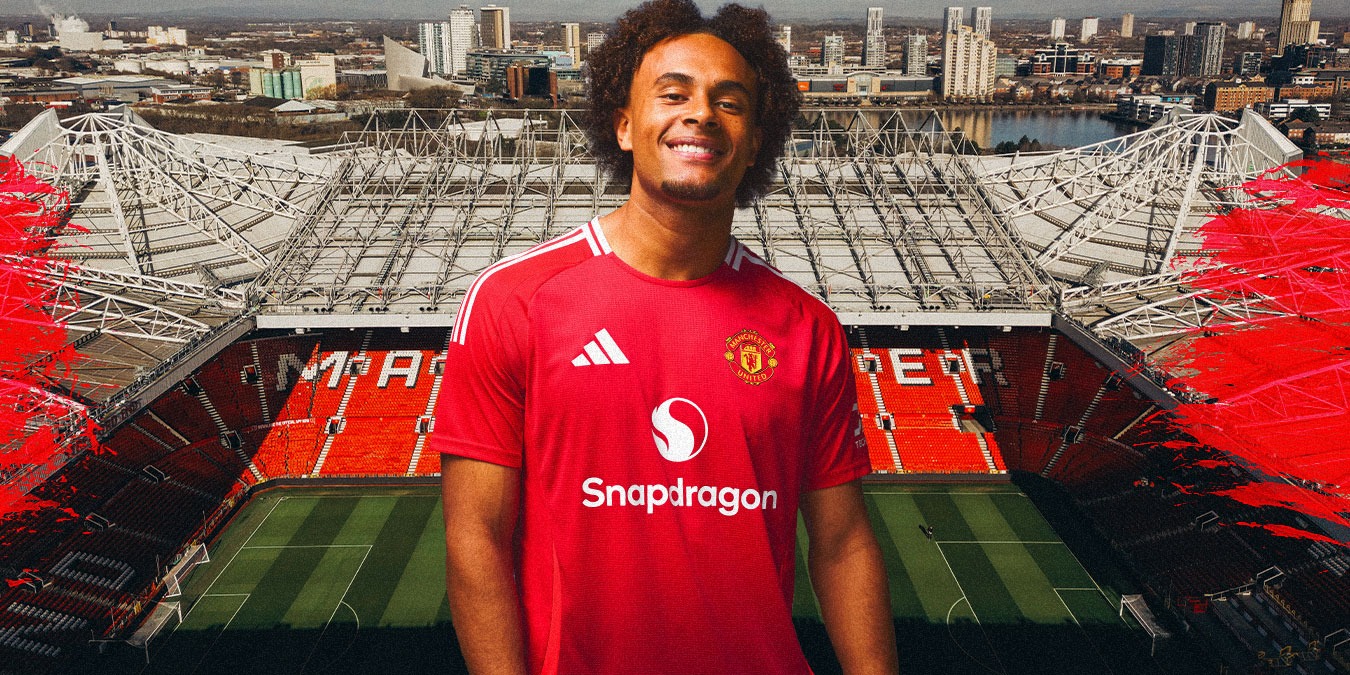Manchester United’s first major acquisition ahead of the 2024-25 Premier League season is Joshua Zirkzee, and there’s every reason for fans to be excited about this one.
At long last, it seems Manchester United are starting to learn. For years, their strategy when it came to striker reinforcements seemed to revolve around short-term fixes, mostly experienced players past their best who didn’t demand much of a transfer fee.
Zlatan Ibrahimovic, Edinson Cavani and Cristiano Ronaldo were the main ones and admittedly cannot be accused of contributing nothing, though there were also questionable loans for the likes of Radamel Falcao, Odion Ighalo and Wout Weghorst.
But then the arrival last summer of a 20-year-old Rasmus Højlund suggested a fresher approach, and their first reinforcement – at a reported £34 million, costing roughly half what the Dane did – of 2024-25 also looks very much in keeping with a desire to buy potential and develop it.
Joshua Zirkzee might not be a household name to many United supporters, but having only just turned 23, he offers an attractive blend of promise and ready-made ability. While the step up from previous club Bologna – who he helped to Champions League qualification last season – will be significant in terms of demands, pressure, exposure and simply the fact he’s moving to the Premier League, his signing looks an exciting one from the outset.
After all, Manchester United love a maverick centre-forward, and Zirkzee absolutely fits the bill in that regard. Eric Cantona, Dimitar Berbatov and Ibrahimovic are among those to have strutted their stuff on the Old Trafford surface, and Zirkzee is closer in aesthetic style to those than he is to Højlund.
Obviously expectations ought to be tempered; no one is saying Zirkzee will have a Cantona-like impact at United, but the young Dutchman has a pretty unique style for these times that arguably makes him something of a throwback to a bygone era.
If rapid wide forwards (like Marcus Rashford) or strikers who look to burst in behind (such as Højlund) are archetypal of modern football, then Zirkzee is of another time – but that also means he offers United something entirely different.
Moulded by spending his formative years on the Cruyff Courts – caged football pitches pioneered by the Johan Cruyff Foundation – of Schiedam, Rotterdam, Zirkzee’s style of play has many of the street footballer hallmarks you might expect.
For starters, he wants the ball. In Serie A last season, the only forwards to average more than his 49.5 touches per 90 minutes (minimum 900 minutes played) were wingers or wide forwards, and he also averaged 4.3 dribble attempts; again, no recognised centre-forwards ranked higher, with Zirkzee ranking behind just seven wingers.
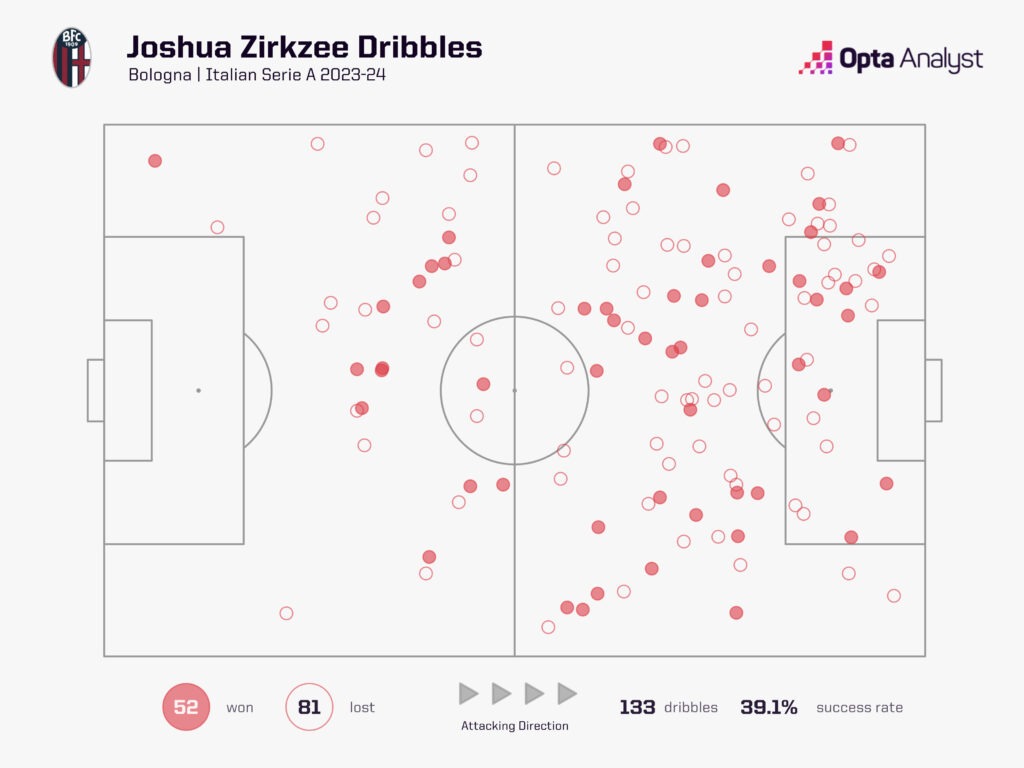
His desire to get on the ball often manifests itself in him dropping into deeper positions and attempting to link the play. But it’s not just as simple as laying off first-time passes to nearby teammates; he can do that, of course, but he also thrives on feeling the presence of a defender behind him, knowing he has the technical ability and general agility to shield the ball and either roll or spin his man.
Thiago Motta and Ronald Koeman, his respective coaches at Bologna and the Netherlands, have both referred to him as a “nine and a half”, which quite succinctly summarises the nuances of his interpretation of the striker role. “I’m not a pure centre forward,” he told Corriere della Sera earlier this year.
“When he has the ball, something always happens,” another Italian newspaper, Corriere dello Sport, said of Zirkzee last season, and it’s easy to see why this was the perception of him. While many might have consigned the technical, skilful number nine to the past, stuck back in the 1990s and early 2000s or having died out following Ibrahimovic’s retirement, Zirkzee is bringing it back – or should that be reimagining it as a “nine and a half”?
The comparisons with past players certainly isn’t a new phenomenon for him. It was put to him earlier this year that Torino coach Ivan Juric was reminded of Ibrahimovic when watching Zirkzee play.
“It’s a great compliment. It’s not so usual to see a tall centre-forward with good technique,” he replied. “I don’t want to appear arrogant. I thank Juric, but yes, I see myself in that [comparison].”
Now, we wouldn’t dream of uttering the words “good touch for a big man”, but Zirkzee can certainly be considered a physical presence even if he’s not the brutish type of frontman. This understandably impacts him somewhat when it comes to pure speed, but with Alejandro Garnacho, Rashford and Højlund already in the side, that shouldn’t be too much of an issue.
Similarly, you’d hope that he’s not being signed to play on the shoulder. United have clearly been impressed with how he contributes to the wider team because that’s how he helped take Bologna to the next level.
We can get an idea of how active he is in attack by looking at sequence data, and when it comes to strikers with the most involvements in shot-ending open-play sequences, Zirkzee’s 144 was second only to Lautaro Martínez (161) in Serie A last season.
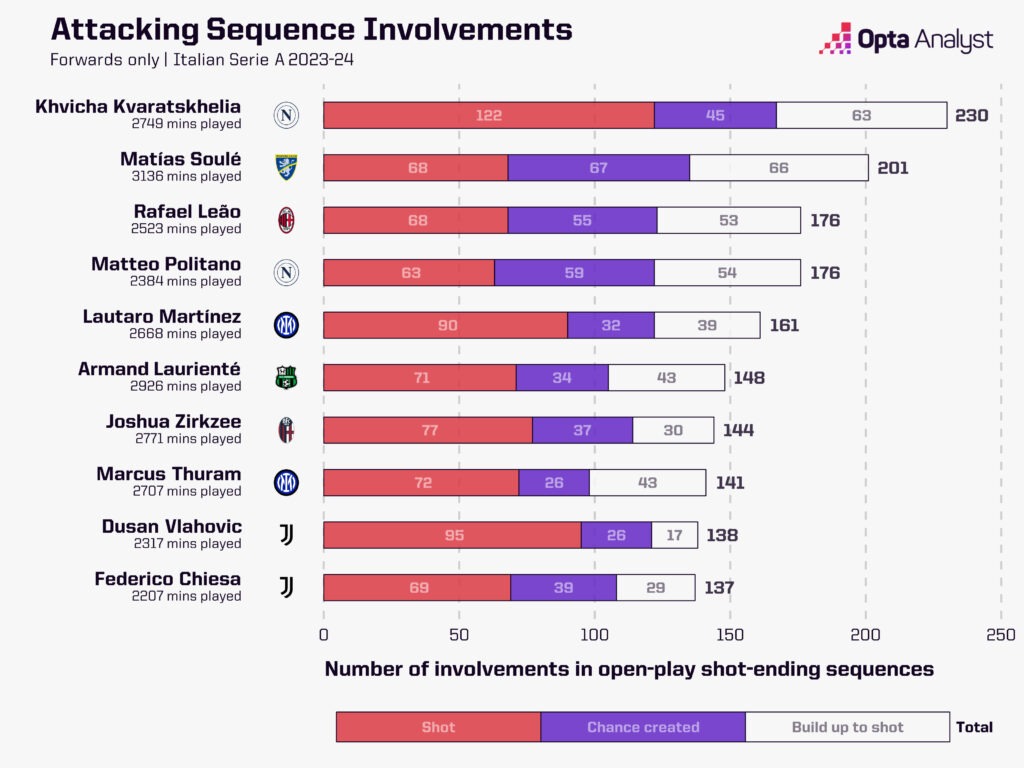
But that figure includes the action of taking a shot himself. Removing shot attempts from the equation provides greater insight into Zirkzee’s habits in the final third because it leaves him with 83 shot-ending sequences in which he’s either been involved in the build-up play or played the pass that set up a chance; only Martínez (88) and Charles De Ketelaere (91) are above him among strikers, though it should be noted the latter offered much less of a goal threat with 31 shots to Zirkzee’s 61.
This data quantifies the Dutchman’s style as an associative centre-forward, while the fact he registered the second most (among strikers) instances of taking a shot and being involved in the build-up (16) proves he still managed to carry a threat in front of goal.
Bearing in mind his tendencies to be more involved in the build-up, it’s also worth looking at Zirkzee’s habits in using the ball. Firstly, his 58 progressive passes was the most of players who spent at least 85% of their minutes in a centre-forward role, and he only ranked behind Martínez (12) for through balls (7) among the same group of players.
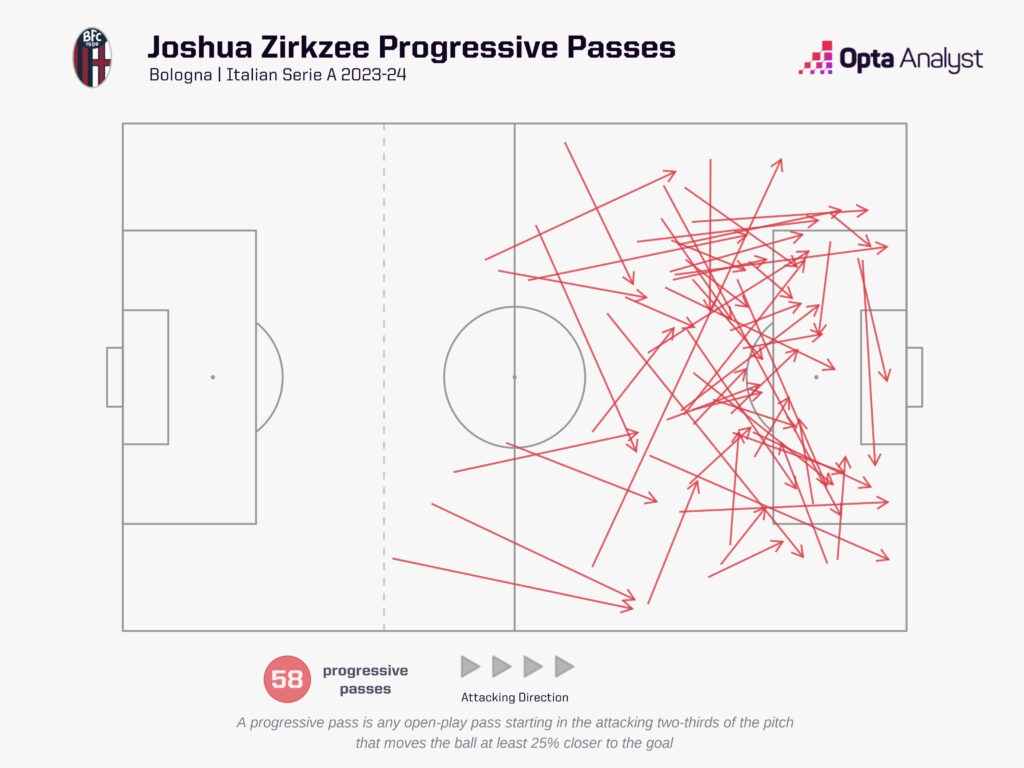
So, while not necessarily being a forward who occupies the most advanced areas of the pitch, he still showed a positive, progressive mentality. That was also reflected by him making the third most progressive carries (148) and most carries ending with a shot or chance created (41) among out-and-out centre-forwards. It’s similarly pertinent to note that no one else in that same player group bettered his 39 chances created in open play.
Zirkzee’s abilities might then be well suited to playing with Rashford and Garnacho, with the Netherlands international’s deeper runs potentially creating more space for those wide forwards who excel in transition or on the counter. Similarly, his ability on the turn could make United even better at sniffing out chances in such situations.
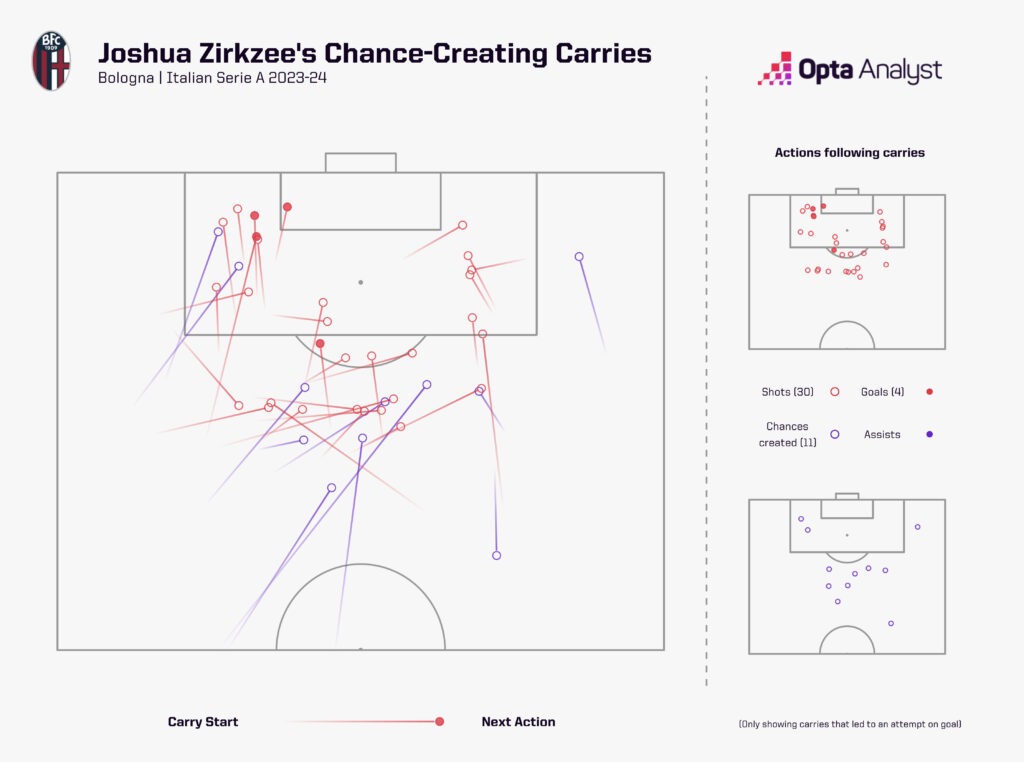
Nevertheless, that does pose the question of how he might work alongside Bruno Fernandes given he takes up advanced areas in midfield, and this will obviously be one of the most important considerations going through Erik ten Hag’s head. But increasing the number of players in that area might be a deliberate ploy to provide the wide men with more gaps to exploit, and who’s to say they can’t thrive in tandem? After all, so much of Zirkzee’s style is centred on combinations, with his 80 layoffs second only to Marcus Thuram in Serie A last season, meaning he could play an important role in freeing Fernandes up to roam more.
There are also going to be questions about whether he can play alongside Højlund effectively, and while we can only speculate on that for the moment, Zirkzee did outline last year (admittedly before Motta’s positional tweak saw him blossom) that he likes to play in a front two. In fairness, they’re different enough that it’s not impossible to imagine them in the same starting XI, and Højlund often appeared to need more help last term.
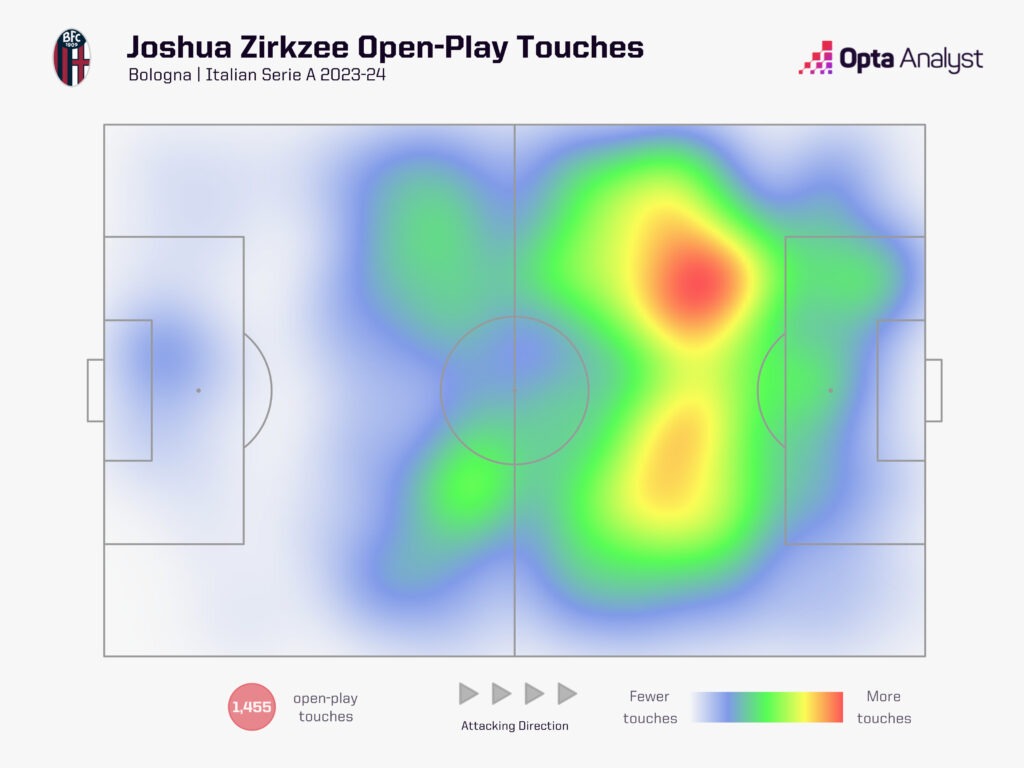
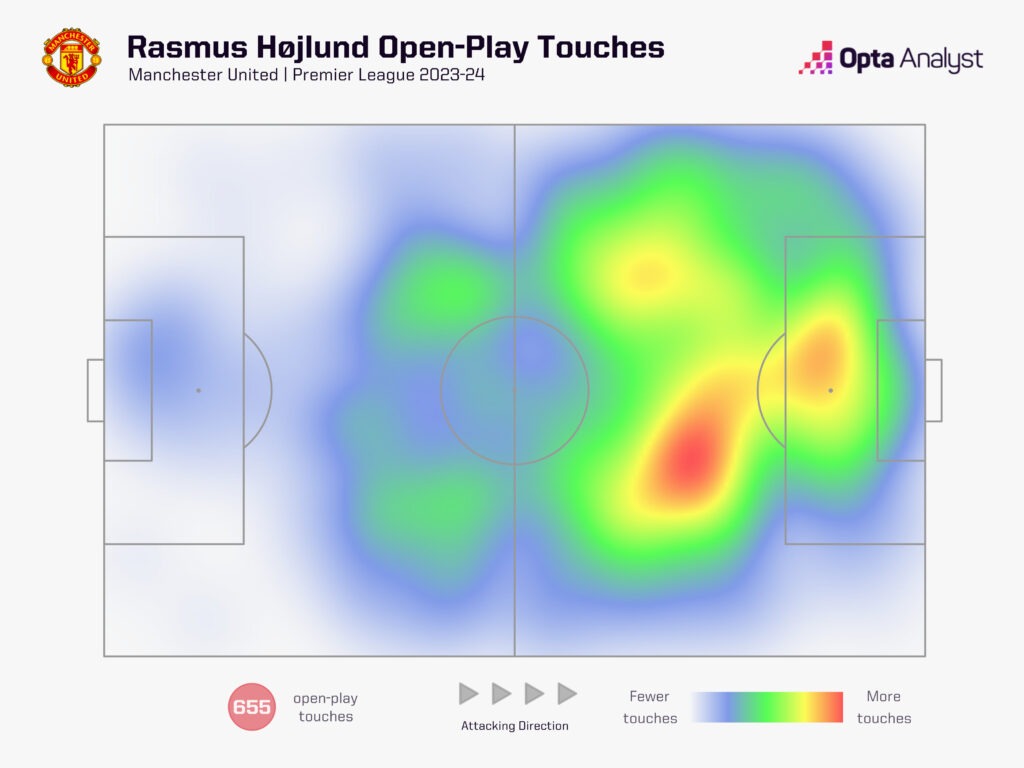
But while Zirkzee’s creative and technical talents could earn him praise, he’s also going to be expected to bring goals. Ten Hag’s men simply didn’t score enough last season, and although it’s not just as simple as the main centre-forward not finishing enough chances, there’ll always be certain expectations on whoever’s leading Manchester United’s attack.
Zirkzee’s overall record in front of goal last season was modest, scoring nine non-penalty goals in 34 Serie A appearances. With 2.8 shots per 90 minutes, he had considerably less of a threat in this regard than the league’s most active forwards, while his 12.8% shot conversion rate paled in comparison to the likes of Albert Gudmundsson (24.6%), Martínez (22.2%), Romelu Lukaku and Gianluca Scamacca (both 20%).
However, you have to acknowledge that both the setup a team plays in and the player’s role can have a massive impact on this. Given Zirkzee routinely took up deeper positions for Bologna, it’s only natural that his shot count suffered somewhat because he’s spending more time away from the most dangerous areas.
So, his average of 0.09 xG per shot wasn’t up there with those who ranked highest for that metric, however, there’s clearly a lot of potential to work with here. After all, eight of those non-penalty goals were scored inside the penalty area, and his 66.7% ‘big chance’ conversion was bettered by only four forwards (minimum 900 minutes played), meaning he was pretty reliable when good opportunities came his way.
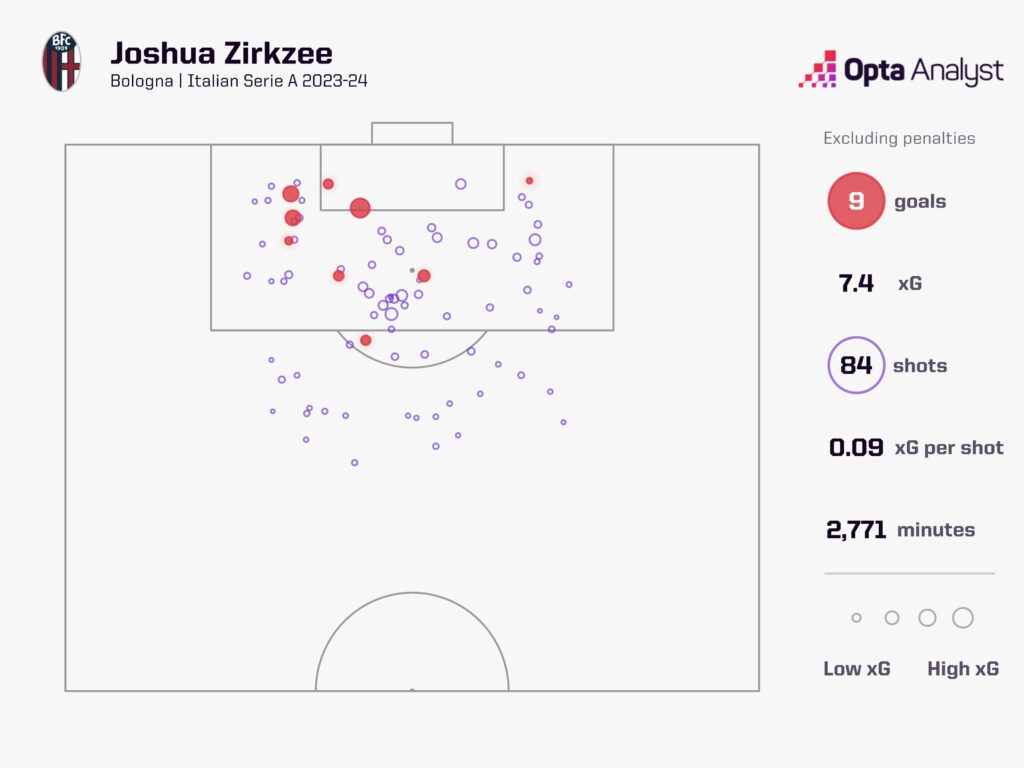
It’s also worth noting that he recognises this potential weakness, accepting in the aforementioned Corriere della Sera interview that he needs to “stay more inside the area”.
Who better to be coached by on a daily basis than Ruud van Nistelrooy, then? The United great returned to Old Trafford this summer to take up a role as one of Ten Hag’s assistants, and there’s undoubtedly a hope in the fanbase that his brilliance as a player will rub off on the club’s young strikers, his compatriot now among them.
After all, the player Zirkzee is most compared to, Ibrahimovic, apparently “couldn’t shoot” when he joined Juventus from Ajax, according to then-manager Fabio Capello. He subsequently got him to study videos of Marco van Basten, and Ibrahimovic ultimately became one of the greatest goalscorers of his generation.
It’s impossible of course to say with any certainty that Zirkzee will be a success at United or not, but at this juncture there’s no debate that he’s got significant potential, offers something different to what they already have, and he’ll get fans off their seats.
That’s a pretty good starting point.
Enjoy this? Subscribe to our football newsletter to receive exclusive weekly content. You should also follow our social accounts over on X, Instagram, TikTok and Facebook.
